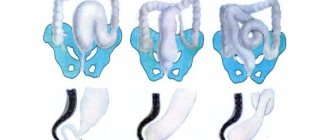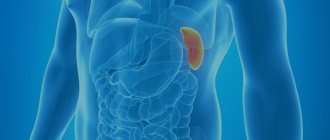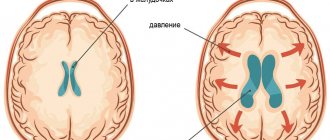Symptoms of meningitis
Signs of meningitis are as follows:
- severe pain in the head,
- temperature, pain in the muscles of the neck,
- hearing loss,
- fainting,
- vomiting and nausea,
- mental problems (paranoia, delusions, excited or apathetic state, increased anxiety),
- convulsive states,
- hives,
- drowsiness.
It all depends on the type of meningitis in adults , so the following stages of the disease can be noted:
- Purulent meningitis . The form is severe, pus appears in the brain capsules. This disease is provoked by bacterial infections, more precisely: staphylococcus, streptococcus, pneumococcus, meningococcus.
- Serous meningitis . The disease is less severe than the first option. At the time of inflammation, no pus appears. This is a kind of viral meningitis. This category includes such types as tuberculosis, influenza, mumps, and syphilitic.
Depending on the course of the disease, the following forms are observed:
- Instant. Symptoms of meningitis in children appear instantly. A person can die in the first 24 hours after infection.
- Spicy. Infectious type meningitis occurs within a couple of days after infection. A person can die instantly. Meningitis symptoms in adults have a bright course.
- Chronic. Symptoms gradually appear and get worse.
Depending on the duration of meningitis and the proliferation of inflammation, there are the following forms:
- Basal. Inflammation occurs in the center of the brain.
- Convexital. Pathological processes concern convex areas of the brain.
- Total. Inflammation affects all parts of the brain.
- Spinal. Inflammation is observed on the surface of the spinal cord.
Depending on the severity, the disease can be mild, moderate or severe.
Support and follow-up
The consequences of meningitis can have a huge negative impact on a person's life, their family and the local community, both financially and emotionally. Sometimes complications such as deafness, learning difficulties or behavioral disorders are not recognized by parents, carers or health professionals and therefore go untreated.
The consequences of meningitis often require long-term treatment. The permanent psychosocial impact of disability resulting from meningitis may create a need for medical care, educational assistance, and social and human rights support. Despite the high burden of meningitis on patients, their families and communities, access to services and support for these conditions is often insufficient, especially in low- and middle-income countries. Persons with disabilities due to meningitis and their families should be encouraged to seek services and advice from local and national disability societies and other disability-focused organizations where they can receive vital advice on their rights, economic opportunities and social life, so that people who have become disabled due to meningitis can live a full life.
Causes of the disease
The main causes of meningitis in children, symptoms and signs, lie in various infectious pathogens. The types of disease differ from each other depending on the sources:
- Bacterial. Often the disease is provoked by microbes, in particular, we are talking about staphylococcus, streptococcus, meningococcus, and E. coli.
- Viral. People suffering from meningitis often have herpes, mumps, and influenza viruses.
- Candida. Occurs due to candida and critococci.
- Simple microbes. These include amoebas and toxoplasma.
In a separate group, diseases of a combined form appear. In this situation, the disease appears due to several different pathogens.
Consequences
Severe consequences of meningitis are more often recorded in young children and with delayed treatment.
If the diagnosis is not made on time and therapy is delayed, dangerous complications develop: sepsis, endocarditis, pneumonia, abscess or cerebral edema.
The most common consequences of meningitis suffered in childhood:
- hydrocephalus;
- mental retardation;
- epileptic seizures;
- paresis;
- decreased or loss of hearing;
- damage to the cranial nerves.
Even with a successful outcome, after discharge the child experiences asthenoneurotic conditions: sleep disturbance, anxiety, headaches, memory loss, fatigue.
How can you get infected?
If you are interested in how you can become infected with meningitis, then first you should know about the way the infection multiplies. The methods of its reproduction are different, but the most common are:
- Airborne (the patient may sneeze and cough).
- Contact and household (personal hygiene rules are not followed).
- Oral-fecal (eating unwashed foods or eating with unwashed hands).
- Hematogenous (infection occurs through blood).
- Lymphogenic (infection through lymph).
- Placental (at the time of pregnancy and birth of a child from mother to her fetus).
- If a person bathes in dirty water, the infection enters the body.
The incubation period for this disease ranges from 2 to 4 days, this period from infection to the first signs. But sometimes it lasts a couple of hours or, on the contrary, it takes up to 20 hours. It is also important to consider that the disease can be primary and secondary. The first option is an independent disease. The second is a consequence of the fact that there is already an infection in the body, for example, a person suffers from influenza, otitis media, tuberculosis.
meningitis symptoms
If it is serous meningitis, then it is considered contagious. If the disease is secondary, then other people will not become infected with it.
Meningitis
The source of the disease are patients with generalized forms of meningococcal infection, acute nasopharyngitis and “healthy” carriers.
There is a fairly wide ratio between patients and bacteria carriers (1:2000 - 1:50,000). During periods of outbreaks, up to 3% of the population of bacteria carriers is registered, during epidemics - up to 30%. The carrier period is about 3 weeks. In 70%, bacterial carriage ceases within 1 week.
In patients with chronic diseases of the nasopharynx, this period is significantly longer. The most virulent strains are isolated by patients with generalized forms. Despite this, their rapid hospitalization and isolation do not have such an impact on the spread of infection as it does in “healthy” carriers.
Meningitis carriers are identified during mass examination of individuals from foci of the disease or accidentally, during examination of smears taken from the mucous membrane of the nasopharynx. Carriers of meningococci do not have any symptoms of the disease. The more severe the epidemic situation, the more carriers of the infection are identified in groups.
Out of 200 bacteria carriers, 1 bacteria carrier gets sick.
Rice. 3. The mechanism of transmission of meningococcal infection is aerosol (droplet).
Who is at risk?
A key factor contributing to the onset of meningitis is a weak immune system. It is the body’s defense against various infections. Human immunity becomes weak due to:
- previously suffered infectious diseases (respiratory, pneumonia, pharyngitis, influenza, sore throat),
- chronic pathologies, especially syphilis, HIV, tuberculosis, liver cirrhosis, severe stress,
- vitamin deficiency and strict diets,
- head and back injuries,
- total hypothermia of the body,
- alcohol and drug abuse,
- long-term use of tablets with non-compliance with recommendations.
All this can cause infection in a person, as the body becomes weak.
When should you see a doctor?
Every person needs to know how to detect signs of meningitis in children . There is no need to delay contacting a doctor if you often experience headaches, nausea and vomiting, an increase in body temperature, photophobia, sensitivity to sounds, or muscle pain in the back of the head. Also considered key symptoms are apathy and a constant desire to sleep, fainting, anxiety, and convulsions. A rash with meningitis is also observed; it affects the skin and mucous membranes. Mental disorders are also observed.
diagnosis of meningitis
Meningitis must be treated by a doctor in the infectious diseases department.
Epidemiological surveillance
Epidemiological surveillance, from case detection to investigation and laboratory confirmation, is essential for successful control of meningococcal meningitis. Main objectives of surveillance:
- detection and confirmation of disease outbreaks;
- monitoring incidence trends, including the distribution and evolution of serogroups and serotypes;
- assessing the burden of disease;
- monitoring of pathogen resistance to antibiotics;
- monitoring the circulation, distribution and evolution of individual strains;
- assessing the effectiveness of strategies to control meningitis, in particular vaccine prevention programs.
How to prepare for going to the doctor?
To go to the doctor, you don’t need to make any extensive preparations; on the contrary, if there are symptoms of meningitis , you shouldn’t put off going to the doctor, in this case you need to react immediately. Just remember all the signs that you had and tell your doctor about them. This will help make a correct diagnosis. You can't ignore these signs. Signs of meningitis in an adult can appear within a couple of hours, so urgent help is needed to avoid complications and even death.
Diagnostic methods
Any of the manifestations of meningitis should make the doctor suspect an infection. It is necessary to urgently hospitalize the patient for emergency diagnostic measures, including:
- lumbar puncture, during which spinal fluid is collected;
- clinical blood test, which determines the concentration of leukocytes and erythrocyte sedimentation rate;
- urine test indicating the presence of protein;
- fundus examination;
- radiography;
- computed tomography.
After instrumental confirmation of the diagnosis, intensive therapy begins.
How is the treatment carried out?
Treatment of meningitis is performed using several methods:
- Antimicrobial. Used when illness is caused by germs.
- Antiviral. Here doctors prescribe interferon and glucocorticosteroids to block the spread of the virus and improve the functioning of the immune system.
- Antifungal. If the disease appears due to candida, then antimycotic medications are used.
Therapy is also aimed at eliminating symptoms, that is, they give pain-relieving injections, normalize body temperature, and eliminate intoxication and dehydration.
Misconceptions regarding the treatment of meningitis
- You can get meningitis if you don't wear a hat. Usually these phrases scare children. Sources of infection are considered to be a consequence of the inflammatory process, but not cold.
- Meningitis is not a dangerous disease at all. In reality, death is possible.
- Meningitis cannot be cured. In reality, fungal and bacterial forms can be treated with drugs, since special drugs have been created against such infections. If the form is viral, then things are worse, since there are no effective antiviral agents.
- After meningitis, a person is prescribed disability. In reality, after suffering bacterial meningitis, only 20% of people become disabled. The most common complication is hearing loss, but there are also problems with remembering and completing schoolwork if meningitis is detected in children.
Key Facts
- Meningitis is a severe disease with a high mortality rate, leading to serious long-term complications.
- Meningitis remains one of the world's greatest health problems.
- Epidemics of meningitis occur throughout the world, especially in sub-Saharan Africa.
- Meningitis can be caused by many microorganisms, including bacteria, viruses, fungi and parasites.
- Bacterial meningitis is of particular concern. About one in ten patients die from this type of meningitis, and one in five develop severe complications.
- The most effective way to provide long-term protection against the disease is through safe and inexpensive vaccines.
This fact sheet focuses on the four main causes of acute bacterial meningitis:
- neisseria meningitidis (meningococcus)
- streptococcus pneumoniae (pneumococcus)
- haemophilus influenzae (hemophilus influenzae)
- streptococcus agalactiae (group B streptococcus)
Worldwide, more than half of all fatal cases of meningitis are caused by these bacteria, which also cause a number of other serious illnesses such as sepsis and pneumonia.
Other common causes of meningitis include other bacteria, such as mycobacterium tuberculosis, salmonella, listeria, streptococcus and staphylococcus, some viruses, such as enteroviruses and mumps virus, some fungi, especially cryptococcus, and parasites, such as amoebas.
What prevention is there?
There is a special vaccination against meningitis. This is what helps prevent the spread of the disease. It should be done for people who often communicate with infected people. Doctors also recommend doing this to children, as they are often exposed to this disease. Vaccination against meningitis is indicated for people with weak immune systems.
Moreover, prevention consists of increasing human immunity. It is necessary to strengthen the body, lead a healthy lifestyle, play sports, often be in the fresh air, and also protect yourself from infectious sources. You can also drink complexes with vitamins and minerals to boost your immunity. It is very important to maintain a balanced diet.










